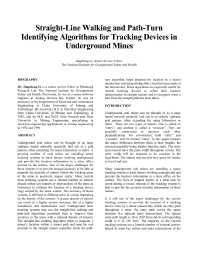Mining Publication: Straight Line Walking and Path-Turn Identifying Algorithms for a Tracking Device Used in Underground Mines
Original creation date: January 2010
Underground coal mines can be thought of as large coplanar tunnel networks generally laid out in a grid pattern, often extending for many kilometers or miles. A growing number of coal mines are installing miner tracking systems to track miners working underground and provide the location information to a mine office located on the surface. One of the major challenges for these systems is to provide enough accuracy to be able to pinpoint the location of miners within the working areas of the mine to positively impact safety. Many current mine tracking systems use a limited number of sensors placed within key tunnels or intersections of the mine as references to estimate the location of a tracking device (tag) carried by the mine worker. The accuracy of those systems is different in different areas in a mine depending on the density of the sensors. A greater density of sensors can result in a higher system accuracy, but at a higher installation and maintenance cost. Underground mine tracking systems may use the straight-line walking and path-turn algorithms presented here to improve their accuracy in the areas with a reduced density of sensors. The straight-line walking algorithm helps to pinpoint a miner’s location within a tunnel path and map his real location to the straight tunnel centerline while the path-turn algorithm helps pinpoint his location in a tunnel intersection and acknowledge that a turn has been made at the intersection. These algorithms are especially useful for inertial tracking devices to refine their location determination in straight tunnels and to recognize when a turn from the straight path has been taken.
Authors: J Li
Conference Paper - January 2010
NIOSHTIC2 Number: 20036704
Proceedings of the ION International Technical Meeting (ITM) 2010, January 25-27, 2010, San Diego, California. Fairfax, VA: The Institute of Navigation, 2010; :244-249
See Also
- Above-the-Earth Field Contours for a Dipole Buried in a Homogeneous Half-Space
- Advanced Tutorial on Wireless Communication and Electronic Tracking: Mine Operations Center (MOC)
- Algorithms to Identify Its Own and Surrounding Tunnels for an Underground Tracking Device
- Exploration of Two Position Adjustment Methods for Underground Mine Tracking Systems
- Investigation of the Jacking Force Capability of Tunnel Liners
- Mining Communications and Tracking
- Modeling Natural Gas Explosions for Coal Mine Safety
- Propagation of UHF Radio Waves in Limestone Room and Pillar Mines
- Technology News 544 - New Measurement Tool to Validate Wireless Communications and Tracking Radio Signal Coverage in Mines
- Waveform Generator-Package and Receiver: Mancarried and Helicopter Receiver Portion
- Page last reviewed: 9/21/2012
- Page last updated: 9/21/2012
- Content source: National Institute for Occupational Safety and Health, Mining Program


 ShareCompartir
ShareCompartir
